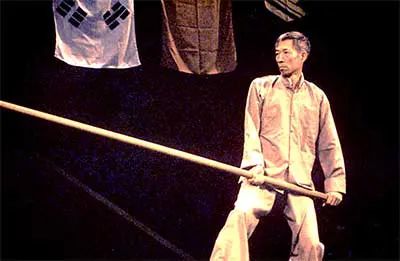Joint Release for Weight Transmission

15/05/2024
By Maksem Manler
Tension isn’t just an inconvenience — it’s a blockade. When you’re holding tension in a joint, you're effectively placing a physical and neurological bottleneck in the system. It’s like trying to run power through a kinked hose. The signals get distorted, the movement becomes segmented, and most importantly, the feeling of “wholeness” or connected flow is lost.
What’s often missed is that this tension isn’t purely muscular — it’s often ligamentous or fascial. We’re talking about deep tension stored in the supporting structures around the joint — places your mind isn’t used to visiting. That’s why you can think you’re “relaxed” and still feel like you’re moving through mud.
This is especially noticeable when weight transmission feels like it’s hitting a wall halfway through your body. The most common example? You shift your intent downward, expecting the ground to respond, but instead you feel like your weight is stuck in your waist or hip. That's not poor structure — that’s a joint refusing to laugh.
The Concept of "Making Joints Laugh"
I started using the phrase “make the joints laugh” as a cue to help myself break through these deeper, almost subconscious levels of holding. Why? Because laughter, at its core, is involuntary. You don’t try to laugh — it erupts. That’s the level of release we’re aiming for in the joints. It’s not a manual override where you stretch or wiggle to loosen things up. It’s a surrender so total that the joint feels like it’s laughing itself open.
This might sound abstract, but in practice, this cue helps bypass the habit of doing too much. When I frame my intent as “let the joint laugh,” the surrounding tissues stop guarding, the joint stops bracing, and I begin to feel that elusive spaciousness between bones.
Space in the Joints: The Gateway to Weightlessness
When joints release properly, there’s a very specific and unmistakable sensation: space. Not the kind of space you imagine between objects — but the kind of internal dimensionality that feels like your bones are floating away from each other ever so slightly.
It’s subtle. But once you tune into it, it becomes addictive. Suddenly your movements don’t feel like effort dragging through structure. They feel like intention flowing through space.
And that’s not just poetry. The proprioceptors inside your ligaments and joint capsules — like the Ruffini endings and Pacinian corpuscles — literally downregulate muscular activity when they detect joint decompression. This is why opening space in the joint isn’t just a nice feeling — it directly turns off the unnecessary muscle tone. You get to move more with less, because the muscles aren’t trying to stabilize what the ligaments already surrendered.
The Pole Rotation: Releasing the Final Boss
The most profound example of this, for me, was the pole rotation exercise. Everyone talks about “using the waist” — but that can easily become a trap where you end up locking your femurs and over-rotating the lumbar to compensate.
It wasn’t until I got serious about releasing the femur heads — and specifically the femoral ligaments — that something clicked. For me, their release was like facing a major boss in a video game. Once it let go, the pole started feeling like its rotation occured by itself but through the joint axis.
This wasn’t a strength improvement. It was a shift in how my weight organized itself. The pole moved because my skeleton was transmitting the rotation like a chain reaction — clean, unbroken, and free of compression. Don't get me wrong, it is nowhere near perfect or even remotely close to being what Grandmaster Chu Shong Tin could do, however, for me it was a breakthrough just being able to get it off the ground. I had never been able to even get it off the ground even using muscle.
Releasing Ligaments: Why Multiple Muscles Turn Off at Once
A single ligament can influence an entire constellation of muscle tone. When you release a ligament — especially those deep ones like the iliofemoral or sacroiliac ligaments — your body doesn’t interpret it as “just one thing letting go.” The nervous system perceives it as a global update: this joint is now safe to release.
Suddenly, multiple muscles that were guarding around that joint switch off. You didn’t stretch them. You didn’t cue them. You simply created the conditions for the brain to stop protecting. This is the missing piece most people skip — they try to force release through muscular manipulation, when in reality the root signal lives in the ligaments.
Practical Suggestions, Without the Fluff
Forget “tips and tricks.” Here’s what actually helped me:
- Feel for joint compression, not muscle tension: Tension is the symptom. Compression is the cause. The moment you sense joint surfaces pressing together, back off and find the space.
- Use the ‘laugh’ cue: Invite the joint to laugh. Don’t stretch. Don’t brace. Just frame your intention around surrender and see if the tissues respond.
- Track weight, not shape: Don’t chase positions — chase the experience of weight dropping through your structure. If the weight gets stuck, you’ve found the next place to release.
- Work upstream: If your hands feel heavy or stiff in forms, don’t waste time fiddling with your arms. Check your hips, your sacrum, your femurs. Most limb tension starts at the base.
By Maksem Manler